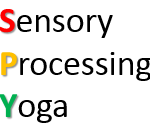Featured Blog Entries

Occupational Therapy & Sensory Processing Yoga
As an Occupational Therapist I predominately work with children and young people who have sensory processing difficulties, which may be a symptom of their autism, ADHA, DCD, Dyspraxia, motor or postural stability difficulties. I have noticed over the years how Sensory Processing Yoga has a positive impact on their physical, emotional and mental well-being.

Sensory Processing Yoga
Sensory Processing Disorder is a condition that exists when sensory signals don’t get organized into appropriate responses and an individual may exhibit clumsiness, poor motor skills and behaviour difficulties as a result of their sensory systems becoming over responsive to sensory input or under responsive so they want to seek out more.
INTRODUCTION TO SENSORY INTEGRATION AND YOGA
14th October 2022
Overview
- This course will provide a foundation in understanding how yoga can be used as a therapeutic tool to support individuals with sensory processing difficulties.
- The course will combine theory with practice in exploring the different sensory systems, yoga poses, breathing exercises and mindful activities to support body awareness, core stability, motor planning and regulation.
- The course will provide a variety of yoga poses, breathing based activities and tools which can be used in a variety of settings and cohort of clients. The course is child-focused but can be applied across the lifespan.
- The course will provide a foundation in understanding how different yoga poses and breathing exercises can support clients in a variety of settings either providing 1-2-1 intervention or as a group which can be used in a hospital setting.
- There is a practical element to the course so please ensure you have access to a gym /yoga mat, space to practice and wear comfortable clothes.
Objectives
- To gain an understanding of how yoga can support certain sensory systems
- To gain knowledge of different yoga poses, breathing exercises and mindful activities which can support regulation, motor planning and postural stability.
- To gain confidence in a foundation of yoga poses and breathing practices that can be used to support body awareness, gross motor skills, emotional regulation and well-being which can be used in a variety of settings
Who should attend this live online training day?
- Open to all – Therapists, Teachers, SENCO, Parents.
- No previous experience in yoga is required.
For more information and booking details click here.
Sensory Integration Network Conference
This weekend I am presenting at the Sensory Integration Network Conference about Sensory Processing Yoga – with the focus being from ideas to action. Although I am very excited to share my journey so far and how my project has evolved over the years. I am equally excited to share my vision for this project. Yoga is becoming increasingly popular across various populations as a means to reconnect with our body, declutter our mind and relax our nervous state and it is through the combination of the asana (pose), meditation (mindfulness) and pranayama (breathing) that this takes place. I am thrilled to be a pioneer for Sensory Processing Yoga because by reconnecting with our bodies we can learn to feel, move and grade our movements , through the art of mindfulness we can learn to tune into to our inner body cues and through the practice of breathing we can deactivate the sympathetic nervous state and stimulate the parasympathetic nervous state bringing harmony to the autonomic nervous system easing anxiety and stress all if which can support children with sensory processing difficulties.
How does yoga support the tactile system?
I often have people ask me how does yoga support the tactile system and how can we weave this sensory system into the practice if we are to consider Sensory Processing Yoga.
The role of the tactile system takes the form of either protective or discriminative. It protects us from pain and temperature whilst helps use discriminate textures, shapes, pressure helping us to use a pen, finding something in the bottom of our bag, sense a stone in our shoe and do our fastenings on our clothes.
In our yoga poses we tend to have either our hands or feet on the mat to help us ground, connect to the earth and stabilise ourselves and maybe if we took our awareness to that area it would help use focus and notice what we are feeling through our fingers, hands toes and feet.
So let’s begin:
Sit on your mat and look at your hands.
Can you touch each finger individually on one hand with the thumb of that hand. Can you do both hands simultaneously? Can you do it with your eyes open, eyes closed?
Clench your fists of your hands and hold this for 15 seconds.
Notice how it feels and name it: tight, warm, closed, squeezed
Now spread your fingers of your hands wide and hold like this for 15 seconds. Name how it feels: stretched, wide, open, tingly, spread, dry
On each hand can you rub each finger with your thumb with small rotations – notice if one way is easier than the other. Does each finger feel the same or do they feel different – some softer, drier, smoother than others?
Bring you hands on to the mat in front of you and spreading your fingers place your hands down on the mat. Can you press down a little firmer under your fingers tips. Do you see your nails changing a little as you press down a little more? Can you lift your fingers a little so your knuckles press down more?
Now with this awareness come up on to all fours. Shift your weight forward a little so your hands become heavier and press down more. Now shift your weight back slightly so there is less weight through your hands. Find the position when the weight is even.
Close your eyes and feel the mat – name it – smooth, bumpy, rough, cold, hot.
Sensory Processing Yoga Workshop
- Date: Mon 27th Jan 2020
- Price: £60.00
- 10am – 5pm
Book through Beacon House
Gain a good understanding of the therapeutic practice of yoga to support children with sensory processing difficulties and sensory attachment, and how this can support self-regulation, body awareness and motor skills with simple routines and practical techniques to use at home and in school. We will combine theory and practice, engaging in various forms of yoga through the practice of postures, breathing techniques and relaxation.
Who this course is for
No previous knowledge required. Aimed at teachers, SENCOs, parents, teaching assistants and therapists (18+). Please feel free to bring your own yoga mat however mats will be provided if needed. Please wear loose comfortable clothes e.g. t-shirt & joggers. Refreshments are provided, please bring a light lunch.
Learning outcomes
- Understanding the effects on the nervous system on self-regulation
- Sensory integration and neuroplasticity and how yoga fits
- How poses, breath work, meditation, and relaxation have an impact on the nervous system.
- Develop tools to support sensory motor disorders – Dyspraxia, Postural Motor Disorder
- Sensory Modulation – How to balance and support the nervous system with yoga
About the trainer
Mel Campbell is an Occupational Therapist advanced sensory integration practitioner working with children with developmental trauma using the principles of sensory attachment. She has been teaching yoga for over 15 years and brings to her practice the understanding of how yoga can support young people to develop resilience and self-awareness and self-regulation.
Strategies for Autism: Cobra with expandable ball
Children need strategies for their autism. This video demonstrates the use of an expandable ball & the cobra pose to help with their breathing.
Children with Sensory Processing Difficulties will benefit from this practice.

